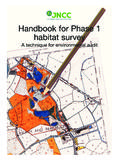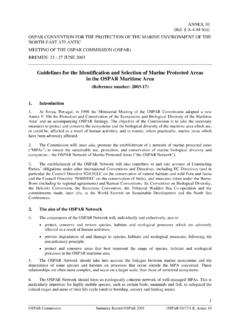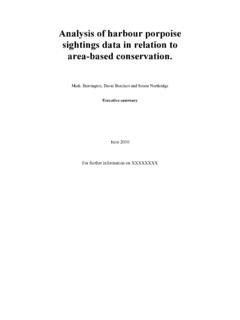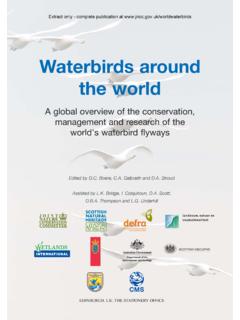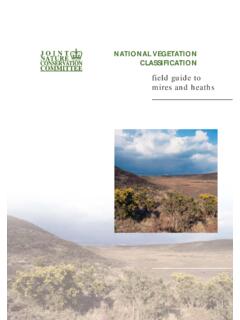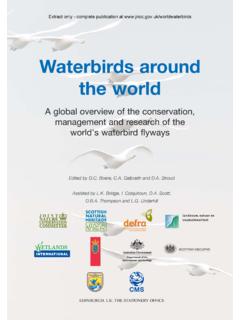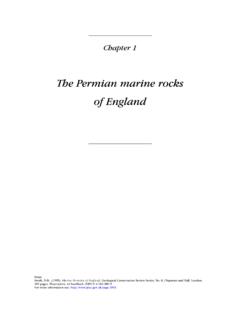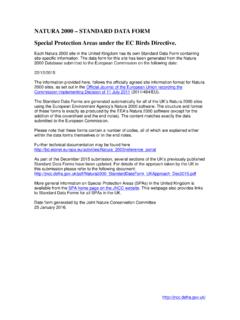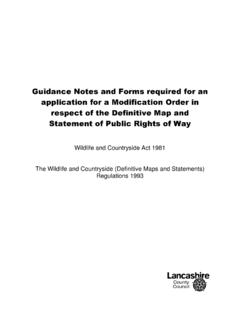Transcription of Guidelines for the Selection of Biological SSSIs - …
1 Guidelines for the Selection of Biological SSSIs Part 1: Rationale, Operational Approach and Criteria for Site Selection Editors Ian Bainbridge, Andy Brown, Nichola Burnett, Paul Corbett, Christina Cork, Richard Ferris, Mike Howe, Ant Maddock, Ed Mountford, Stewart Pritchard Part 2: Detailed Guidelines for Habitats and Species available on the JNCC website Revision based upon Ratcliffe, , ed. 1989. Guidelines for Selection of Biological SSSIs . Peterborough, Nature Conservancy Council. Joint Nature Conservation Committee 2013 ISBN 978-1-86107-625-0 Guidelines for the Selection of Biological SSSIs - Part 1: Rationale, Operational Approach and Criteria for Site Selection 2 Contents 2 Foreword 3 Part 1 Rationale, Operational Approach and Criteria for Site Selection 1.
2 The purpose of the Guidelines 4 2. The purpose of SSSIs within biodiversity and nature conservation strategies 5 3. The concept of Special Scientific Interest 8 4. The rationale for the evaluation and Selection of a national series of Biological SSSIs 10 5. The principles of site evaluation and Selection 19 Typicalness 21 Fragility 21 Size 21 Diversity 23 Naturalness 24 Rarity 25 Ecological coherence 28 Potential value 29 Recorded History 29 6. International importance 30 7. Assessment of site value 32 8. Boundary definition, size and site integrity 34 9. Evaluation of habitat mosaics 39 10.
3 Evaluation of species group combinations 40 11. Total extent of SSSIs 40 12. Summary 41 13. References for Part 1 42 Part 2: Detailed Guidelines for Habitats and Species The 2011/12 revision of Part 1 of the Guidelines was undertaken by an Editorial team comprising: Ian Bainbridge: Scottish Natural Heritage Editor in Chief Andy Brown: Natural England Nichola Burnett: Joint Nature Conservation Committee Paul Corbett: Department of the Environment Northern Ireland Christina Cork: Natural England Richard Ferris: Joint Nature Conservation Committee Mike Howe: Countryside Council for Wales (now Natural Resources Wales) Ant Maddock.
4 Joint Nature Conservation Committee Ed Mountford: Joint Nature Conservation Committee Stewart Pritchard: Scottish Natural Heritage Guidelines for the Selection of Biological SSSIs - Part 1: Rationale, Operational Approach and Criteria for Site Selection 3 FOREWORD It is now over sixty years since the concept of protecting our most valuable species and habitats through the designation of Sites of Special Scientific Interest was established in Great Britain. Since then, legislation has been amended, improved and devolved, but the SSSI series has remained a cornerstone of Britain s biodiversity conservation policy and practice.
5 SSSIs are an important component of the protection of important and threatened habitats and species, of a habitat network approach to conservation, and latterly as part of a wider landscape-scale ecosystem approach to the sustainable management of our environment. The formal Guidelines for the Selection of Biological SSSIs were originally published in 1989, as a means of explaining the scientific rationale underpinning the Selection of special sites across Great Britain. Since then, much new European, UK and devolved legislation has been introduced, and nature conservation responsibilities have been devolved, with the formation of the three country nature conservation bodies, and with JNCC providing a co-ordinating function.
6 However, it is important that the Guidelines continue to reflect a common approach to the biology and ecology underpinning site Selection in the context of this devolved governance, and continue to recognise their relevance to the parallel process of site Selection in Northern Ireland so as to support ensure a coherent approach at UK level. This revision has updated Part 1 (previously Parts A and B) of the Guidelines for the first time since 1989. The fundamental basis of the evaluation and Selection processes remains largely unchanged. This revised guidance has recognised and taken into account the developing ecosystem approach to biodiversity conservation, our European responsibilities, climate change issues and a number of other changes in our knowledge and understanding that have developed in the last twenty-four years.
7 The Guidelines recognise that Britain is largely a cultural landscape, and that human actions have had a pervasive influence on almost all of our ecosystems, habitats and species. Nature conservationists especially value those habitats that continue to exhibit a high degree of naturalness and diversity among other well-established criteria. The Guidelines place added emphasis on the incorporation of underlying ecological processes in the definition of site interest and boundaries (such as coastal erosion or accretion, and fluvial processes in rivers and floodplains) and emphasise the need for agency staff to think flexibly to take into account likely environmental change.
8 These Guidelines therefore enable the system to cope with dynamic change. As such, they lay down basic tenets for the evaluation and Selection of sites but leave flexibility to deal with ongoing environmental change. We should expect the SSSI series to track changes in our environment. As new areas become of special interest, we should notify them and as the interest of others changes as a result of broader or intrinsic natural environmental change they should be reassessed. Most importantly, we must all continue to approach the series as a GB-wide network. Biodiversity does not reflect our internal political boundaries, and a common basis of science, a uniform framework and common standards provide strength to the system established to protect our nationally and internationally important wildlife sites.
9 Peter Bridgewater, Joint Nature Conservation Committee Poul Christensen CBE, Natural England Andrew Thin, Scottish Natural Heritage Morgan Parry, Countryside Council for Wales (now Natural Resources Wales) Patrick Casement, Council for Nature Conservation and the Countryside, Northern Ireland Guidelines for the Selection of Biological SSSIs - Part 1: Rationale, Operational Approach and Criteria for Site Selection 4 PART 1: RATIONALE, OPERATIONAL APPROACH AND CRITERIA FOR SITE Selection 1 The purpose of the Guidelines The Guidelines for the Selection of Biological SSSIs provide a consistent rationale for the evaluation and Selection of Biological Sites of Special Scientific Interest ( SSSIs ) throughout Great Britain.
10 SSSIs are designated in accordance with the duties in law placed upon each of the statutory nature conservation bodies (SNCBs1) to notify as a Site of Special Scientific Interest any area of land which in its opinion is of special interest by reason of any of its flora, fauna, geological, geomorphological or physiographical features. The Guidelines are intended primarily to help SNCB staff in the Selection of Biological SSSIs , but they are also intended as a public statement of the Selection principles for all interested parties. The rationale and criteria for the Selection of geological and physiographical sites are published separately (Ellis et al 1996).
